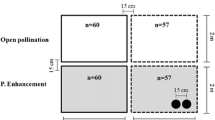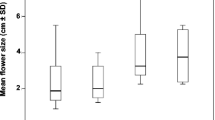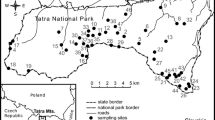Summary
The reproductive success and energy budgets of single and multiflowered plants of Trillium erectum L. (Liliaceae) were assessed over a period of 4 years. Plants with more than one flower were found to attract more pollinators, to be less vulnerble to predation by Tortricid moths, and to produce more seeds than single flowered plants. Despite the reproductive superiority exhibited by multiflowered plants, most plants (85%) in the population studied were single flowered. It is shown that even though the insect interactions make it advantageous to produce more than one flower, most plants lack the energy to do so. The optimality approach which has guided previous studies of this kind is criticzied.
Similar content being viewed by others
References
Beattie AJ, Breedlove DE, Ehrlich PR (1973) The ecology of the pollinators and predators of Frasera speciosa. Ecology 54:81–91
Brandt RP (1916) Notes on the California species of Trillium L. III. Seasonal changes in Trillium species with special references to the reproductive tissues. Univ Calif Publ Bot 7:39–68
Chapman PJ, Lienk SE (1970) Tortricid fauna of apple in New York. Spec Publ. NY State Agric Exp Sta, Cornell University, Geneva NY
Cook RE (1979) Patterns of juvenile mortality and recruitment in plants in Topics in Plant Population Biology. Solbrig OT, Jain S, Johnson G, and Raven P (eds), pp 207–231 Columbia University Press, NY
Dyer AF (1963) Endosperm development after controlled pollination within and between species of Trillium and Paris. Chromosoma 14:549–567
Fernald ML (1950) Gray's Manual of Botany. D. Van Nostrand Company. New York
Ihara M (1973) A facet of the breeding system in American species of Trillium (Parideae-Liliaceae). Unpubl Master's thesis, Vanderbilt University, Nashville, TN. pp 221
Janzen DH (1967) Synchronization of sexual reproduction of trees within the dry season in Central America. Evolution 21:620–637
Mulligan GA, Kevan PG (1973) Color, brightness, and other floral characteristics attracting insects to the blossoms of some Canadian weeds. Can J Bot 51:1939–1952
Patrick TS (1973) Observations on the life history of Trillium grandiflorum (Michaux) Salisbury. Unpubl Master's thesis, Cornell University, Ithaca, NY. pp 201
Robertson C (1896) Flowers and insects. Bot Gaz 21:266–274
Root RB (1973) Organization of a plant-arthropod association in single and diverse habitats: the fauna of Collards (Brassica oleracea). Ecol Monog 43:95–124
Schemske DW (1980) Evolution of floral display in the Orchid Brassavola nodosa. Evolution 34:489–493
Snedecor GW, Cochran WG (1973) Statistical Methods. Iowa State University Press, Ames, Iowa
Solbrig OT, Newell SJ, Kincaid DT (1980) The population biology of the genus, Viola. I. The demography of Viola sororia. J Ecol 68:521–546
Weed CM (1900) Ten New England Blossoms and their Insect Visitors. Houghton, Mifflin and Co Boston
Werner PA (1975) Predictions of fate from rosette size in teasel. Oecologia (Berl) 20:197–201
Williams GC (1966) Natural selection, the costs of reproduction and a refinement of Lack's principle. Amer Nat 100:687–690
Willson MF, Rathcke BJ (1974) Adaptive design of the floral display in Asclepius syriaca L. Am Midl Nat 92:47–57
Willson MF, Price PW (1977) The evolution of inflorescence size in Asclepius (Asclepiadaceae). Evolution 31:495–511
Willson MF, Miller LJ, Rathcke BJ (1979) Floral display in Phlox and Geranium: adaptive aspects. Evolution 33:52–63
Zar JH (1974) Biostatistical Analysis. Prentice-Hall, Inc Englewood Cliffs NJ
Zimmerman M (1980) Reproduction in Polemonium: predispersal seed predation. Ecology 61:502–506
Author information
Authors and Affiliations
Rights and permissions
About this article
Cite this article
Davis, M.A. The effect of pollinators, predators, and energy constraints on the floral ecology and evolution of Trillium erectum . Oecologia 48, 400–406 (1981). https://doi.org/10.1007/BF00346501
Received:
Issue Date:
DOI: https://doi.org/10.1007/BF00346501




